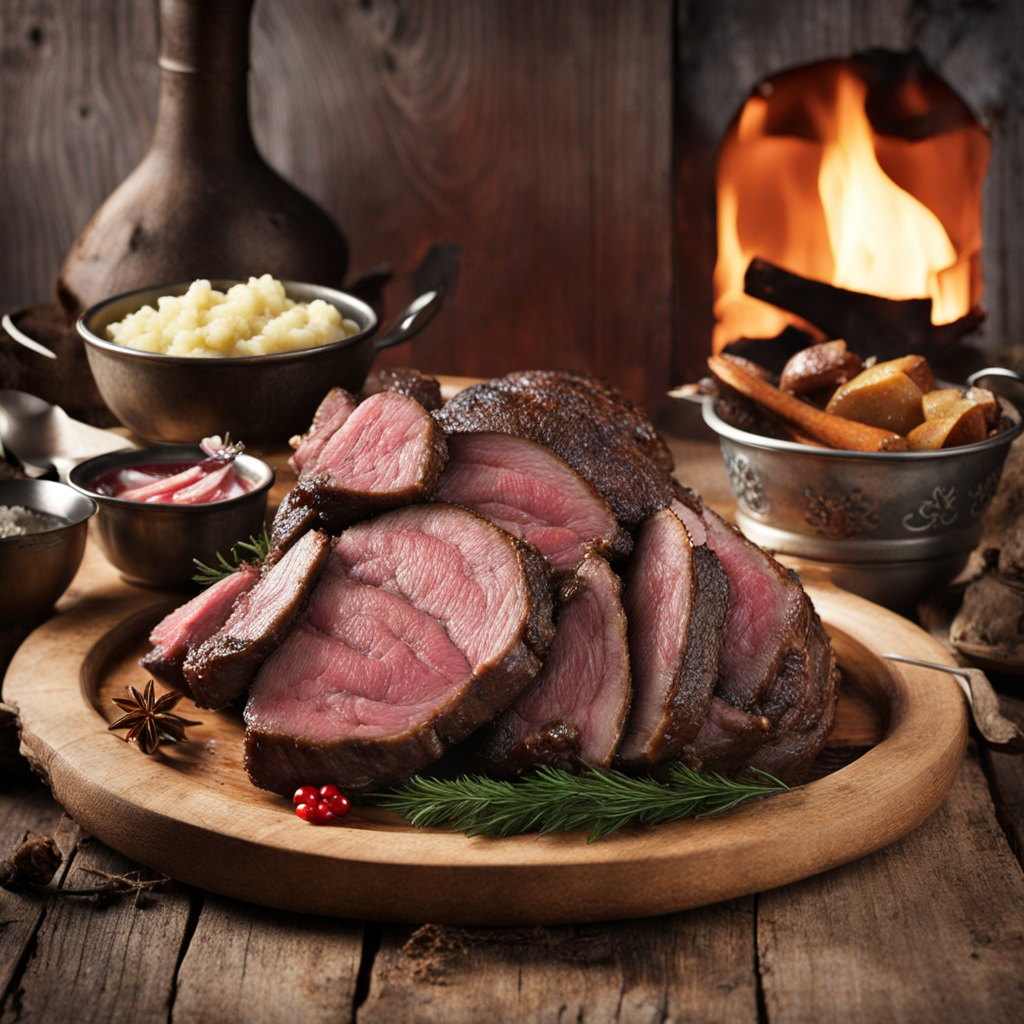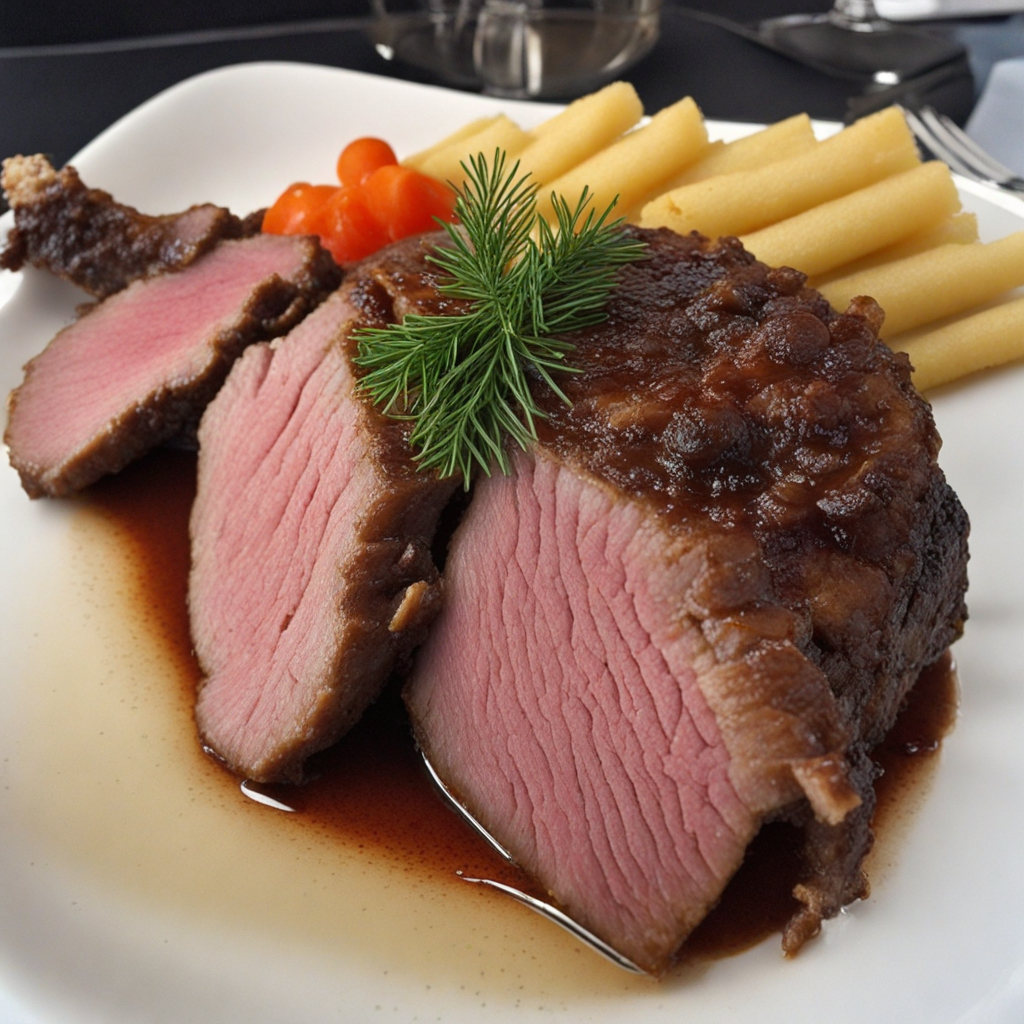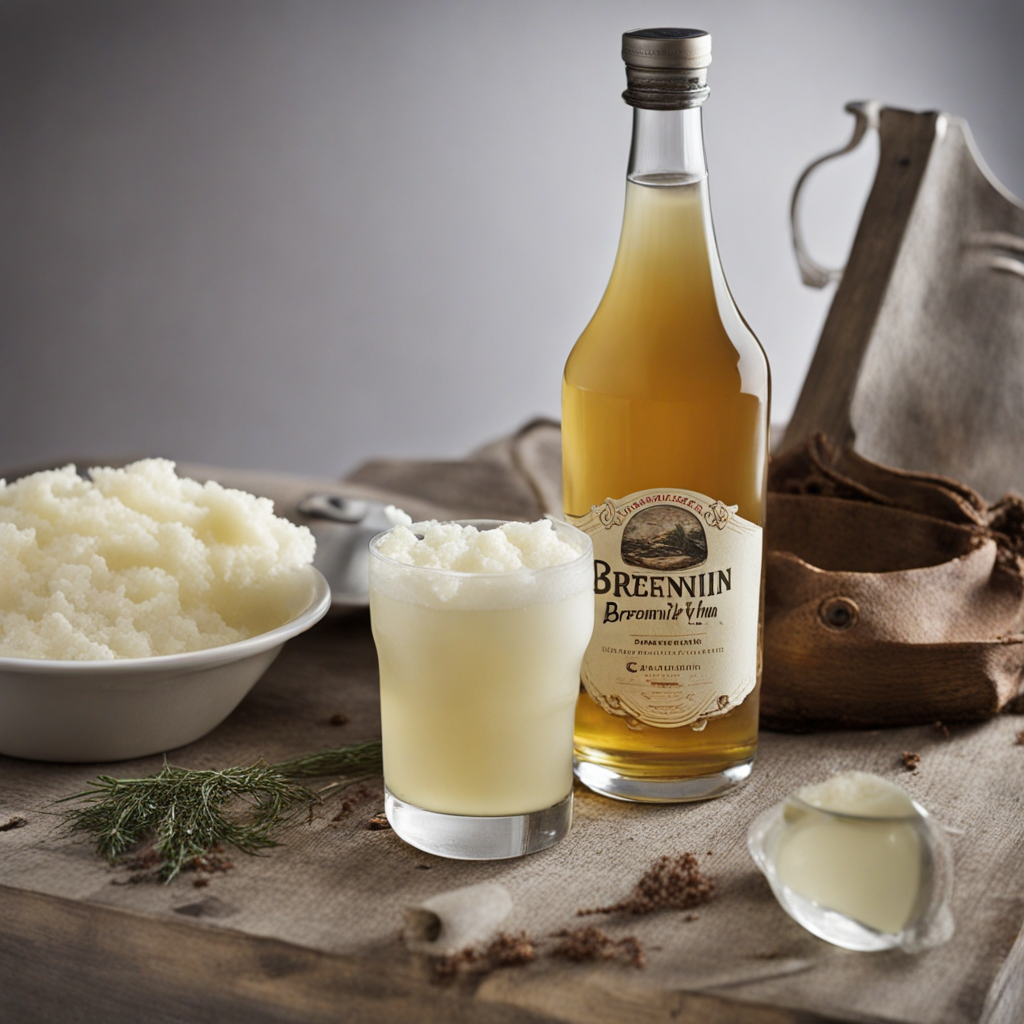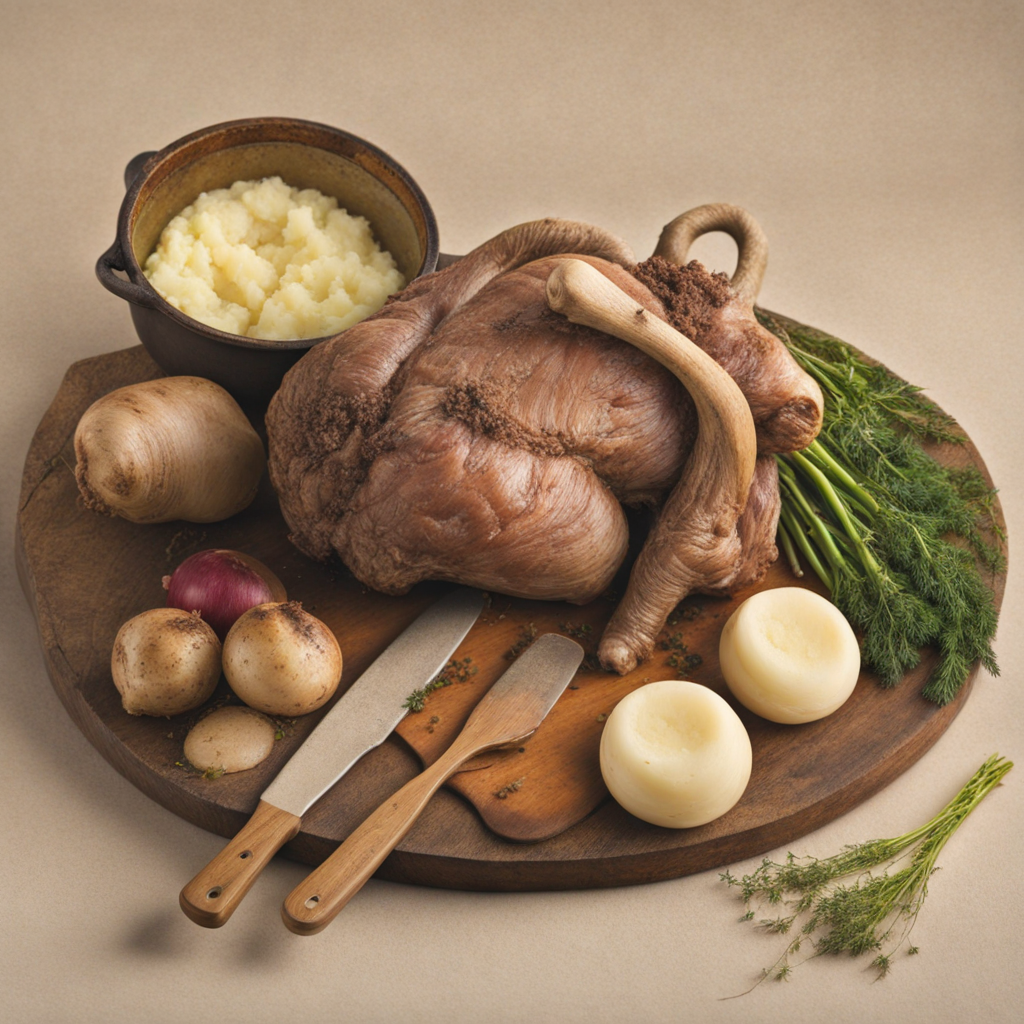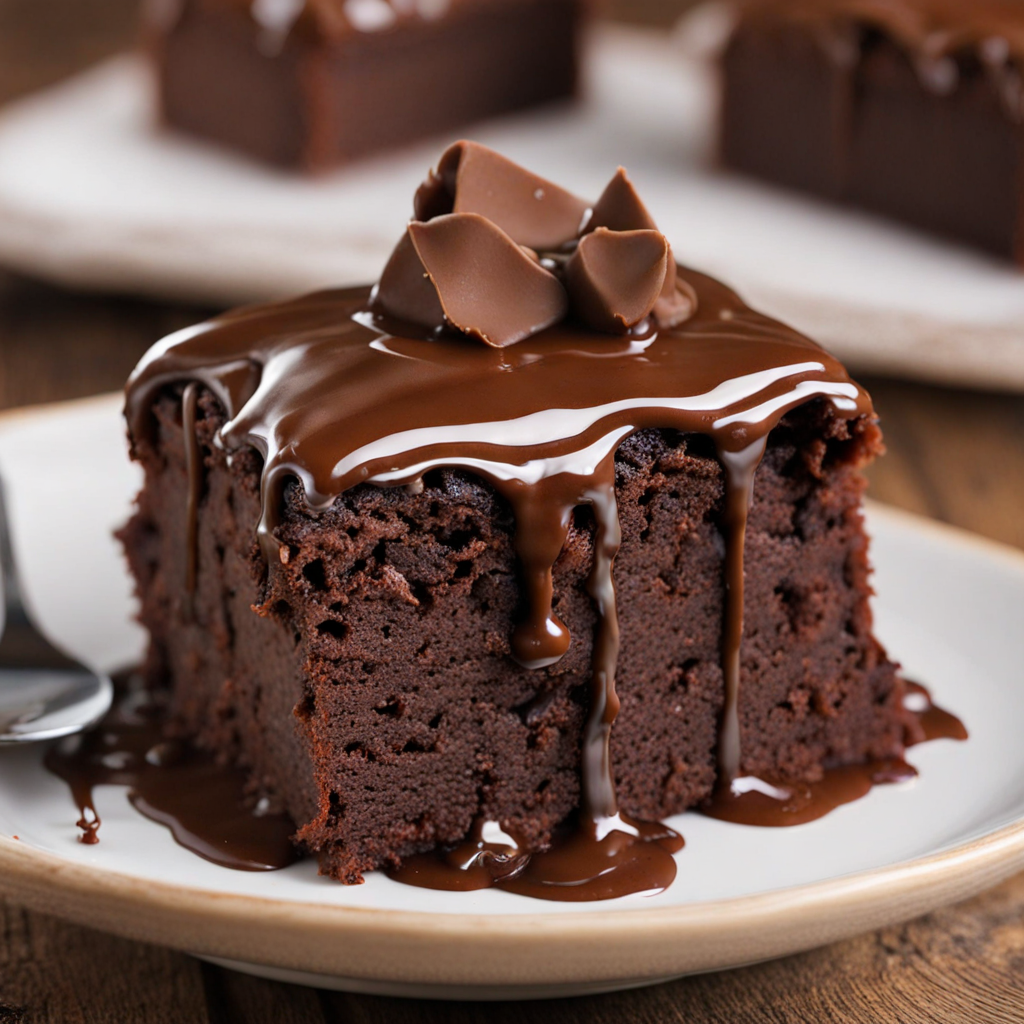Hangikjöt
Hangikjöt is a traditional Icelandic dish that features smoked lamb, which is a beloved staple in Icelandic cuisine. The process of making Hangikjöt involves slowly boiling the lamb to tender perfection before it's smoked over a mix of birch and other woods, imparting a rich, aromatic flavor that is distinctively Icelandic. This method of preparation not only enhances the meat's natural flavors but also preserves it, allowing it to be enjoyed throughout the long, cold winter months. The result is a succulent, smoky lamb that is both savory and deeply satisfying, making it a favorite among locals and visitors alike. Typically served thinly sliced, Hangikjöt is often accompanied by traditional side dishes such as potatoes in white sauce, pickled vegetables, and a generous dollop of mustard. The combination of the tender, smoky meat with the creamy potatoes and tangy pickles creates a delightful medley of flavors and textures that tantalize the palate. Many Icelanders also enjoy Hangikjöt on rye bread, where the earthy flavors of the bread complement the rich lamb perfectly, making for a simple yet fulfilling meal. In addition to its delicious taste, Hangikjöt is steeped in cultural significance, often served during festive occasions and holiday feasts, particularly at Christmas. This dish not only provides a taste of Iceland's culinary heritage but also offers a glimpse into the resourcefulness of Icelandic people, who have long relied on smoking and preserving their meats to withstand the harsh climate. Exploring Hangikjöt is a flavorful journey into the heart of Icelandic traditions, leaving a lasting impression on anyone who experiences its unique and hearty flavor.
How It Became This Dish
Origin of Hangikjöt Hangikjöt, the traditional smoked lamb of Iceland, has its roots deeply embedded in the island's agrarian culture, which developed in the harsh landscapes and climates of the North Atlantic. The practice of preserving meat through smoking and drying can be traced back to the Viking Age when the early settlers of Iceland brought with them their culinary traditions. These early Icelanders faced a challenging environment, marked by long winters and limited agricultural diversity. As such, they relied heavily on livestock, primarily sheep, which were well-suited to the rugged terrain and could be raised with minimal resources. The name "Hangikjöt" itself translates to "hanged meat," a nod to the traditional method of preparation. After slaughtering a lamb, the meat would be salted and then hung in a smokehouse, where it would be exposed to the cold, smoky air generated from burning birch and other local woods. This process not only preserved the meat for long periods but also imbued it with a distinct flavor that has become synonymous with Icelandic cuisine. The preservation method was essential for survival, especially during the long winters when fresh food was scarce. Cultural Significance Hangikjöt holds a special place in Icelandic culture, especially during the Christmas season. It is customary for Icelanders to enjoy Hangikjöt as part of their festive meals, often served with boiled potatoes, a creamy white sauce, and various types of pickled vegetables. The dish is a symbol of warmth and family togetherness, reflecting the importance of communal meals in Icelandic society. The preparation and consumption of Hangikjöt are imbued with traditions that have been passed down through generations, reinforcing familial bonds and cultural identity. The significance of Hangikjöt extends beyond mere sustenance; it embodies the resilience and resourcefulness of the Icelandic people. The ability to preserve meat in a way that could last through the harsh winters speaks to the ingenuity required to thrive in such an unforgiving environment. Additionally, the dish represents a connection to the land, with its reliance on local ingredients and traditional methods honoring Iceland's agricultural heritage. Development Over Time Over the centuries, the methods and consumption of Hangikjöt have evolved, influenced by both internal and external factors. In the 19th century, as Iceland began to open up to trade with other nations, new ingredients and culinary practices started to make their way into Icelandic kitchens. Despite these changes, the traditional methods of preparing Hangikjöt remained largely untouched, a testament to the dish's deep-rooted significance in Icelandic culture. In the modern era, there has been a resurgence in interest in traditional Icelandic foods, including Hangikjöt. As globalization brought a plethora of culinary influences, many Icelanders turned back to their roots, embracing local and traditional foods as a source of national pride. This revival is not just about nostalgia; it also reflects a broader movement towards sustainability and the importance of knowing where one's food comes from. Hangikjöt is now celebrated at food festivals and featured in upscale restaurants, often prepared with a modern twist, showcasing the versatility of this age-old dish. Regional Variations While Hangikjöt is a national dish, there are regional variations that reflect the diverse culinary practices across Iceland. In some areas, the meat is smoked with different woods, lending unique flavors that vary from one region to another. In addition, the choice of side dishes can differ, with some families opting for more contemporary accompaniments, such as roasted vegetables or artisan breads, while others adhere strictly to traditional pairings. The diversity in preparation and presentation underscores the adaptability of Hangikjöt, allowing it to maintain relevance in the ever-changing landscape of Icelandic cuisine. This flexibility has enabled the dish to appeal to both the older generation, who cherish the nostalgia of traditional recipes, and younger generations, who are eager to experiment and innovate while still honoring their culinary heritage. Modern-Day Consumption Today, Hangikjöt is widely available in Iceland, not just during the Christmas season, but year-round. Supermarkets and local butcher shops often carry pre-packaged versions of the smoked lamb, making it accessible to a broader audience. However, many families still prefer to make their Hangikjöt at home, often using recipes passed down through generations. This practice not only preserves the traditional methods but also fosters a sense of community as families gather to prepare and celebrate their culinary heritage. Moreover, Iceland's increasing interest in tourism has introduced Hangikjöt to international visitors, who often seek authentic culinary experiences during their travels. Restaurants across the country have begun to feature Hangikjöt on their menus, presenting it as a must-try dish for anyone wanting to experience the essence of Icelandic cuisine. This globalization of the dish has further cemented its status as a symbol of Icelandic identity, bridging the gap between tradition and modern culinary trends. Conclusion: A Culinary Legacy The history of Hangikjöt is a rich tapestry that intertwines the environmental challenges faced by early Icelanders with their innovative culinary practices. This traditional dish not only serves as a means of sustenance but also as a vessel of cultural significance, embodying the resilience and resourcefulness of the Icelandic people. As it continues to evolve and adapt to modern tastes, Hangikjöt remains a cherished staple of Icelandic cuisine, celebrating a legacy that honors the past while looking toward the future. The enduring popularity of Hangikjöt is a testament to its importance in Icelandic culture, ensuring that this remarkable dish will continue to be enjoyed for generations to come.
You may like
Discover local flavors from Iceland


